Worldwide Examination of Magnetic Responses to Heavy Metal Pollution in Agricultural Soils
Abstract
1. Introduction
2. Materials and Methods
2.1. Data Extraction
2.2. PC-PMF Model
2.3. Multivariate Statistical Analysis
2.4. Contamination Assessment and Regression Analysis
3. Results
3.1. Geographical Content and Source of HMs
3.1.1. Geographical Distribution Characteristics of HMs
3.1.2. Quantifying the Source Contributions of HMs Using PC-PMF
3.2. Magnetic Parameters
3.3. Correlation between Magnetic Susceptibility and HMs
3.3.1. Pearson’s Correlation Analysis
3.3.2. Redundancy Analysis
3.4. Magnetic Susceptibility Indicates HM Contamination
3.4.1. Evaluation of Pollution Indices of HMs
3.4.2. Regression Analysis of PLI and
4. Conclusions
- There are significant regional differences in the global distribution of HMs, which are relatively high in India, the USA, Africa, etc. Additionally, the PC-PMF model reveals global variations in pollution sources, with the industry being the primary contributor (31.5%). Effective soil management policies can be formulated by considering regional variations in source contributions.
- The total magnetic concentration of the agricultural soils in different regions varied significantly, and the ranged from 0.59% and 12.85%, with the majority of the samples being below 6%, suggesting that magnetic particles in the soils are mainly influenced by human activities.
- Pearson’s correlation analysis showed that soil magnetic susceptibility was significantly and positively correlated with specific heavy metals, such as Pb, Zn, and Cu with (r = 0.51–0.53) and Mn and Fe with (r = 0.50–0.53), and combined with the RDA analysis, it was determined that Pb, Zn, Cu, and As were the key factors influencing the differences in soil magnetic response.
- The global agricultural soil HM contamination assessment indicated a moderate level of soil contamination, with a PLI of 2.03. A significant positive correlation was observed between magnetic susceptibility () above and both heavy metal concentration and the PLI (r = 0.72), affirming as a robust predictor of HM contamination. These insights are crucial for developing effective soil management strategies and conducting large-scale soil quality assessments.
Author Contributions
Funding
Institutional Review Board Statement
Data Availability Statement
Conflicts of Interest
Appendix A
| Region | Cr | Cu | Ni | Pb | Zn | As | Cd | Mn | Fe |
|---|---|---|---|---|---|---|---|---|---|
| ANZ | 48 | 11 | 15 | 13 | 31 | 3 | 0.14 | 388 | - |
| EU | 22 | 12 | 14 | 15 | 48 | 6 | 0.15 | - | - |
| AF | 35 | 25 | 20 | 20 | 71 | 1.5 | 0.098 | 600 | 35,000 |
| USA | 30 | 14.4 | 13.5 | 18.1 | 58 | 5.2 | 1.6 | 492 | 19,500 |
| ROA1 | 59.5 | 38.9 | 29 | 27 | 70 | 6.83 | 0.41 | 488 | 22,979 |
| CA | 125 | 14 | 58 | 12 | 52 | 28.4 | 0.102 | 500 | 39,500 |
| ME | 90 | 45 | 68 | 20 | 95 | 13 | 0.3 | 850 | 14,200 |
| BR | 20.71 | 5.94 | 7.63 | 19.48 | 45.41 | 0.96 | 0.15 | 173 | 16,048 |
| IN | 100 | 55 | 76 | 12.5 | 70 | 6 | 0.2 | 600 | 47,200 |
| NC | 53.9 | 20 | 23.4 | 23.6 | 67.7 | 9.2 | 0.074 | 482 | 27,300 |
| SC | 53.9 | 20 | 23.4 | 23.6 | 67.7 | 9.2 | 0.074 | 482 | 27,300 |
| ROA2 | 59.5 | 38.9 | 29 | 27 | 70 | 6.83 | 0.41 | 488 | 22,979 |
References
- Solgi, E.; Esmaili-Sari, A.; Riyahi-Bakhtiari, A.; Hadipour, M. Soil Contamination of Metals in the Three Industrial Estates, Arak, Iran. Bull. Environ. Contam. Toxicol. 2012, 88, 634–638. [Google Scholar] [CrossRef] [PubMed]
- Shi, T.; Ma, J.; Zhang, Y.; Liu, C.; Hu, Y.; Gong, Y.; Wu, X.; Ju, T.; Hou, H.; Zhao, L. Status of Lead Accumulation in Agricultural Soils across China (1979–2016). Environ. Int. 2019, 129, 35–41. [Google Scholar] [CrossRef] [PubMed]
- Liu, P.; Hu, W.; Tian, K.; Huang, B.; Zhao, Y.; Wang, X.; Zhou, Y.; Shi, B.; Kwon, B.-O.; Choi, K.; et al. Accumulation and Ecological Risk of Heavy Metals in Soils along the Coastal Areas of the Bohai Sea and the Yellow Sea: A Comparative Study of China and South Korea. Environ. Int. 2020, 137, 105519. [Google Scholar] [CrossRef] [PubMed]
- Han, I.; Whitworth, K.W.; Christensen, B.; Afshar, M.; An Han, H.; Rammah, A.; Oluwadairo, T.; Symanski, E. Heavy Metal Pollution of Soils and Risk Assessment in Houston, Texas Following Hurricane Harvey. Environ. Pollut. 2022, 296, 118717. [Google Scholar] [CrossRef] [PubMed]
- Reimann, C.; De Caritat, P. New Soil Composition Data for Europe and Australia: Demonstrating Comparability, Identifying Continental-Scale Processes and Learning Lessons for Global Geochemical Mapping. Sci. Total Environ. 2012, 416, 239–252. [Google Scholar] [CrossRef] [PubMed]
- Tao, H.; Al-Hilali, A.A.; Ahmed, A.M.; Mussa, Z.H.; Falah, M.W.; Abed, S.A.; Deo, R.; Jawad, A.H.; Abdul Maulud, K.N.; Latif, M.T.; et al. Statistical and Spatial Analysis for Soil Heavy Metals over the Murray-Darling River Basin in Australia. Chemosphere 2023, 317, 137914. [Google Scholar] [CrossRef] [PubMed]
- Huang, Y.; Wang, L.; Wang, W.; Li, T.; He, Z.; Yang, X. Current Status of Agricultural Soil Pollution by Heavy Metals in China: A Meta-Analysis. Sci. Total Environ. 2019, 651, 3034–3042. [Google Scholar] [CrossRef] [PubMed]
- Adimalla, N.; Qian, H.; Wang, H. Assessment of Heavy Metal (HM) Contamination in Agricultural Soil Lands in Northern Telangana, India: An Approach of Spatial Distribution and Multivariate Statistical Analysis. Environ. Monit. Assess. 2019, 191, 246. [Google Scholar] [CrossRef]
- Zang, F.; Wang, S.; Nan, Z.; Ma, J.; Zhang, Q.; Chen, Y.; Li, Y. Accumulation, Spatio-Temporal Distribution, and Risk Assessment of Heavy Metals in the Soil-Corn System around a Polymetallic Mining Area from the Loess Plateau, Northwest China. Geoderma 2017, 305, 188–196. [Google Scholar] [CrossRef]
- Huamain, C.; Chunrong, Z.; Cong, T.; Yongguan, Z. Heavy Metal Pollution in Soils in China: Status and Countermeasures. Ambio 1999, 28, 130–134. [Google Scholar]
- Imseng, M.; Wiggenhauser, M.; Müller, M.; Keller, A.; Frossard, E.; Wilcke, W.; Bigalke, M. The Fate of Zn in Agricultural Soils: A Stable Isotope Approach to Anthropogenic Impact, Soil Formation, and Soil–Plant Cycling. Environ. Sci. Technol. 2019, 53, 4140–4149. [Google Scholar] [CrossRef] [PubMed]
- Beone, G.M.; Carini, F.; Guidotti, L.; Rossi, R.; Gatti, M.; Fontanella, M.C.; Cenci, R.M. Potentially toxic elements in agricultural soils from the Lombardia region of northern Italy. J. Geochem. Explor. 2018, 190, 436–452. [Google Scholar] [CrossRef]
- Morton-Bermea, O.; Hernandez, E.; Martinez-Pichardo, E.; Soler-Arechalde, A.M.; Santa-Cruz, R.L.; Gonzalez-Hernandez, G.; Beramendi-Orosco, L.; Urrutia-Fucugauchi, J. Mexico City Topsoils: Heavy Metals vs. Magnetic Susceptibility. Geoderma 2009, 151, 121–125. [Google Scholar] [CrossRef]
- Yin, Y.; Wang, X.; Hu, Y.; Li, F.; Cheng, H. Soil Bacterial Community Structure in the Habitats with Different Levels of Heavy Metal Pollution at an Abandoned Polymetallic Mine. J. Hazard. Mater. 2023, 442, 130063. [Google Scholar] [CrossRef] [PubMed]
- Alloway, B.J. Sources of heavy metals and metalloids in soils. In Heavy Metals in Soils: Trace Metals and Metalloids in Soils and Their Bioavailability; Alloway, B.J., Ed.; Springer: Berlin/Heidelberg, Germany, 1995; pp. 11–50. [Google Scholar]
- Abel, S.; Nehls, T.; Mekiffer, B.; Mathes, M.; Thieme, J.; Wessolek, G. Pools of Sulfur in Urban Rubble Soils. J. Soils Sediments 2015, 15, 532–540. [Google Scholar] [CrossRef]
- Hoefs, J. Geochemical Fingerprints: A Critical Appraisal. Eur. J. Mineral. 2010, 22, 3–15. [Google Scholar] [CrossRef]
- Erosion, I. Geochemistry in soil science. In Encyclopedia of Soil Science; Springer: Berlin/Heidelberg, Germany, 2007; p. 283. ISBN 978-1-4020-3994-2. [Google Scholar]
- Delbecque, N.; Van Ranst, E.; Dondeyne, S.; Mouazen, A.M.; Vermeir, P.; Verdoodt, A. Geochemical Fingerprinting and Magnetic Susceptibility to Unravel the Heterogeneous Composition of Urban Soils. Sci. Total Environ. 2022, 847, 157502. [Google Scholar] [CrossRef]
- Verosub, K.L.; Roberts, A.P. Environmental Magnetism: Past, Present, and Future. J. Geophys. Res. 1995, 100, 2175–2192. [Google Scholar] [CrossRef]
- Vodyanitskii, Y.N.; Shoba, S.A. Magnetic Susceptibility as an Indicator of Heavy Metal Contamination of Urban Soils (Review). Moscow Univ. Soil Sci. Bull. 2015, 70, 10–16. [Google Scholar] [CrossRef]
- Vollprecht, D.; Bobe, C.; Stiegler, R.; Van De Vijver, E.; Wolfsberger, T.; Küppers, B.; Scholger, R. Relating magnetic properties of municipal solid waste constituents to iron content: Implications for enhanced landfill mining. Detritus 2019, 8, 31–46. [Google Scholar] [CrossRef]
- Magiera, T.; Żogała, B.; Łukasik, A.; Pierwoła, J. Application of Different Geophysical Techniques to Study Technosol Developed on Metallurgical Wastes. Land Degrad. Dev. 2021, 32, 1927–1937. [Google Scholar] [CrossRef]
- Karimi, R.; Ayoubi, S.; Jalalian, A.; Sheikh-Hosseini, A.R.; Afyuni, M. Relationships between Magnetic Susceptibility and Heavy Metals in Urban Topsoils in the Arid Region of Isfahan, Central Iran. J. Appl. Geophys. 2011, 74, 1–7. [Google Scholar] [CrossRef]
- Ayoubi, S.; Karami, M. Pedotransfer functions for predicting heavy metals in natural soils using magnetic measures and soil properties. J. Geochem. Explor. 2019, 197, 212–219. [Google Scholar] [CrossRef]
- Gargiulo, J.D.; Chaparro, M.A.; Marié, D.C.; Böhnel, H.N. Magnetic monitoring of anthropogenic pollution in Antarctic soils (Marambio Station) and the spatial-temporal changes over a decade. Catena 2021, 203, 105289. [Google Scholar] [CrossRef]
- Chaparro, M.A.; Suresh, G.; Chaparro, M.A.; Ramasamy, V.; Sundarrajan, M. Magnetic assessment and pollution status of beach sediments from Kerala coast (southwestern India). Mar. Pollut. Bull. 2017, 117, 171–177. [Google Scholar] [CrossRef] [PubMed]
- Joju, G.S.; Warrier, A.K.; Sali, A.Y.; Chaparro, M.A.; Mahesh, B.S.; K, A.; Mohan, R. An Assessment of Metal Pollution in the Surface Sediments of an East Antarctic Lake. Soil Sediment Contam. Int. J. 2024, 1–22. [Google Scholar] [CrossRef]
- El Baghdadi, M.; Barakat, A.; Sajieddine, M.; Nadem, S. Heavy Metal Pollution and Soil Magnetic Susceptibility in Urban Soil of Beni Mellal City (Morocco). Environ. Earth Sci. 2012, 66, 141–155. [Google Scholar] [CrossRef]
- Canbay, M.; Aydin, A.; Kurtulus, C. Magnetic Susceptibility and Heavy-Metal Contamination in Topsoils along the Izmit Gulf Coastal Area and IZAYTAS (Turkey). J. Appl. Geophys. 2010, 70, 46–57. [Google Scholar] [CrossRef]
- Gubbins, D.; Herrero-Bervera, E. (Eds.) Encyclopedia of Geomagnetism and Paleomagnetism; Springer Science & Business Media: Berlin/Heidelberg, Germany, 2007; pp. 1–1013. ISBN 978-1-4020-3992-8. [Google Scholar]
- Łukasik, A.; Szuszkiewicz, M.; Magiera, T. Impact of Artifacts on Topsoil Magnetic Susceptibility Enhancement in Urban Parks of the Upper Silesian Conurbation Datasets. J. Soils Sediments 2015, 15, 1836–1846. [Google Scholar] [CrossRef]
- Wang, B.; Xia, D.; Yu, Y.; Chen, H.; Jia, J. Source Apportionment of Soil-Contamination in Baotou City (North China) Based on a Combined Magnetic and Geochemical Approach. Sci. Total Environ. 2018, 642, 95–104. [Google Scholar] [CrossRef]
- Szuszkiewicz, M.; Łukasik, A.; Magiera, T.; Mendakiewicz, M. Combination of geo-pedo-and technogenic magnetic and geochemical signals in soil profiles–diversification and its interpretation: A new approach. Environ. Pollut. 2016, 214, 464–477. [Google Scholar] [CrossRef] [PubMed]
- Cao, L.; Appel, E.; Hu, S.; Ma, M. An Economic Passive Sampling Method to Detect Particulate Pollutants Using Magnetic Measurements. Environ. Pollut. 2015, 205, 97–102. [Google Scholar] [CrossRef] [PubMed]
- Prajith, A.; Rao, V.P.; Kessarkar, P.M. Magnetic Properties of Sediments in Cores from the Mandovi Estuary, Western India: Inferences on Provenance and Pollution. Mar. Pollut. Bull. 2015, 99, 338–345. [Google Scholar] [CrossRef] [PubMed]
- Pan, H.; Lu, X.; Lei, K.; Shi, D.; Ren, C.; Yang, L.; Wang, L. Using Magnetic Susceptibility to Evaluate Pollution Status of the Sediment for a Typical Reservoir in Northwestern China. Environ. Sci. Pollut. Res. 2019, 26, 3019–3032. [Google Scholar] [CrossRef] [PubMed]
- Hu, P.; Heslop, D.; Viscarra Rossel, R.A.; Roberts, A.P.; Zhao, X. Continental-Scale Magnetic Properties of Surficial Australian Soils. Earth-Sci. Rev. 2020, 203, 103028. [Google Scholar] [CrossRef]
- Hannam, J.A.; Dearing, J.A. Mapping Soil Magnetic Properties in Bosnia and Herzegovina for Landmine Clearance Operations. Earth Planet. Sci. Lett. 2008, 274, 285–294. [Google Scholar] [CrossRef]
- Johansson, C.; Norman, M.; Burman, L. Road Traffic Emission Factors for Heavy Metals. Atmos. Environ. 2009, 43, 4681–4688. [Google Scholar] [CrossRef]
- Jordanova, N.; Jordanova, D.; Petrov, P. Soil Magnetic Properties in Bulgaria at a National Scale—Challenges and Benefits. Glob. Planet. Chang. 2016, 137, 107–122. [Google Scholar] [CrossRef]
- Thiesson, J.; Boulonne, L.; Buvat, S.; Jolivet, C.; Ortolland, B.; Saby, N. Magnetic Properties of the French Soil Monitoring Network: First Results; European Association of Geoscientists & Engineers: Utrecht, The Netherlands, 2012; pp. 1–306. [Google Scholar]
- Hanesch, M.; Rantitsch, G.; Hemetsberger, S.; Scholger, R. Erratum to “Lithological and Pedological Influences on the Magnetic Susceptibility of Soil: Their Consideration in Magnetic Pollution Mapping [Science of the Total Environment 382 (2007) 351–363]”. Sci. Total Environ. 2008, 396, 86–87. [Google Scholar] [CrossRef]
- Chaparro, M.A.; Nuñez, H.; Lirio, J.M.; Gogorza, C.S.; Sinito, A.M. Magnetic screening and heavy metal pollution studies in soils from Marambio Station, Antarctica. Antarct. Sci. 2007, 19, 379–393. [Google Scholar] [CrossRef]
- Chaparro, M.A.; Chaparro, M.A.; Molinari, D.A. A Fuzzy-Based Analysis of Air Particle Pollution Data: An Index IMC for Magnetic Biomonitoring. Atmosphere 2024, 15, 435. [Google Scholar] [CrossRef]
- Ma, W.; Tai, L.; Qiao, Z.; Zhong, L.; Wang, Z.; Fu, K.; Chen, G. Contamination Source Apportionment and Health Risk Assessment of Heavy Metals in Soil around Municipal Solid Waste Incinerator: A Case Study in North China. Sci. Total Environ. 2018, 631–632, 348–357. [Google Scholar] [CrossRef]
- Schaefer, K.; Einax, J.W. Source Apportionment and Geostatistics: An Outstanding Combination for Describing Metals Distribution in Soil. CLEAN Soil Air Water 2016, 44, 877–884. [Google Scholar] [CrossRef]
- Dong, B.; Zhang, R.; Gan, Y.; Cai, L.; Freidenreich, A.; Wang, K.; Guo, T.; Wang, H. Multiple Methods for the Identification of Heavy Metal Sources in Cropland Soils from a Resource-Based Region. Sci. Total Environ. 2019, 651, 3127–3138. [Google Scholar] [CrossRef]
- Zhou, L.; Zhao, X.; Meng, Y.; Fei, Y.; Teng, M.; Song, F.; Wu, F. Identification Priority Source of Soil Heavy Metals Pollution Based on Source-Specific Ecological and Human Health Risk Analysis in a Typical Smelting and Mining Region of South China. Ecotoxicol. Environ. Saf. 2022, 242, 113864. [Google Scholar] [CrossRef]
- Feng, Y.-X.; Yu, X.-Z.; Zhang, H. A Modelling Study of a Buffer Zone in Abating Heavy Metal Contamination from a Gold Mine of Hainan Province in Nearby Agricultural Area. J. Environ. Manag. 2021, 287, 112299. [Google Scholar] [CrossRef]
- Liu, P.; Hu, W.; Huang, B.; Liu, B.; Zhou, Y. Advancement in researches on effect of atmospheric deposition on heavy metals accumulation in soils and crops. Acta Pedol. Sin. 2019, 565, 1048–1059. [Google Scholar] [CrossRef]
- Wu, J.; Li, J.; Teng, Y.; Chen, H.; Wang, Y. A Partition Computing-Based Positive Matrix Factorization (PC-PMF) Approach for the Source Apportionment of Agricultural Soil Heavy Metal Contents and Associated Health Risks. J. Hazard. Mater. 2020, 388, 121766. [Google Scholar] [CrossRef]
- UNSD. Standard Country or Area Codes for Statistical Use (M49). 2023. Available online: https://unstats.un.org/unsd/methodology/m49/ (accessed on 14 October 2023).
- Paatero, P.; Tapper, U. Positive Matrix Factorization: A Non-negative Factor Model with Optimal Utilization of Error Estimates of Data Values. Environmetrics 1994, 5, 111–126. [Google Scholar] [CrossRef]
- Brown, S.G.; Eberly, S.; Paatero, P.; Norris, G.A. Methods for Estimating Uncertainty in PMF Solutions: Examples with Ambient Air and Water Quality Data and Guidance on Reporting PMF Results. Sci. Total Environ. 2015, 518–519, 626–635. [Google Scholar] [CrossRef]
- Armstrong, R.A. Should Pearson’s correlation coefficient be avoided? Ophthalmic Physiol. Opt. 2019, 39, 316–327. [Google Scholar] [CrossRef]
- Łukasik, A.; Magiera, T.; Lasota, J.; Błońska, E. Background Value of Magnetic Susceptibility in Forest Topsoil: Assessment on the Basis of Studies Conducted in Forest Preserves of Poland. Geoderma 2016, 264, 140–149. [Google Scholar] [CrossRef]
- Deng, L.; Fan, Y.; Liu, K.; Zhang, Y.; Qian, X.; Li, M.; Wang, S.; Xu, X.; Gao, X.; Li, H. Exploring the primary magnetic parameters affecting chemical fractions of heavy metal (loid) s in lake sediment through an interpretable workflow. J. Hazard. Mater. 2024, 468, 133859. [Google Scholar] [CrossRef]
- Lin, Y.; Han, P.; Huang, Y.; Yuan, G.L.; Guo, J.X.; Li, J. Source identification of potentially hazardous elements and their relationships with soil properties in agricultural soil of the Pinggu district of Beijing, China: Multivariate statistical analysis and redundancy analysis. J. Geochem. Explor. 2017, 173, 110–118. [Google Scholar] [CrossRef]
- Gabarrón, M.; Faz, A.; Acosta, J.A. Use of Multivariable and Redundancy Analysis to Assess the Behavior of Metals and Arsenic in Urban Soil and Road Dust Affected by Metallic Mining as a Base for Risk Assessment. J. Environ. Manag. 2018, 206, 192–201. [Google Scholar] [CrossRef]
- Sakizadeh, M.; Zhang, C. Source identification and contribution of land uses to the observed values of heavy metals in soil samples of the border between the Northern Ireland and Republic of Ireland by receptor models and redundancy analysis. Geoderma 2021, 404, 115313. [Google Scholar] [CrossRef]
- Rahman, M.S.; Saha, N.; Kumar, S.; Khan, M.D.H.; Islam, A.R.M.T.; Khan, M.N.I. Coupling of redundancy analysis with geochemistry and mineralogy to assess the behavior of dust arsenic as a base of risk estimation in Dhaka, Bangladesh. Chemosphere 2022, 287, 132048. [Google Scholar] [CrossRef]
- Li, X.; Yang, Y.; Yang, J.; Fan, Y.; Qian, X.; Li, H. Rapid diagnosis of heavy metal pollution in lake sediments based on environmental magnetism and machine learning. J. Hazard. Mater. 2021, 416, 126163. [Google Scholar] [CrossRef]
- Tomlinson, D.L.; Wilson, J.G.; Harris, C.R.; Jeffrey, D.W. Problems in the Assessment of Heavy-Metal Levels in Estuaries and the Formation of a Pollution Index. Helgol. Meeresunters 1980, 33, 566–575. [Google Scholar] [CrossRef]
- Liu, D.; Ma, J.; Sun, Y.; Li, Y. Spatial Distribution of Soil Magnetic Susceptibility and Correlation with Heavy Metal Pollution in Kaifeng City, China. Catena 2016, 139, 53–60. [Google Scholar] [CrossRef]
- McLennan, S.M. Relationships between the Trace Element Composition of Sedimentary Rocks and Upper Continental Crust. Geochem Geophys Geosyst 2001, 2, 2000GC000109. [Google Scholar] [CrossRef]
- Kabata-Pendias, A. Trace Elements in Soils and Plants, 4th ed.; CRC Press: Boca Raton, MA, USA, 2011; ISBN 978-1-4200-9368-1. [Google Scholar]
- Griffith, D.A.; Chun, Y. Soil Sample Assay Uncertainty and the Geographic Distribution of Contaminants: Error Impacts on Syracuse Trace Metal Soil Loading Analysis Results. Int. J. Environ. Res. Public Health 2021, 18, 5164. [Google Scholar] [CrossRef]
- Blundell, A.; Hannam, J.A.; Dearing, J.A.; Boyle, J.F. Detecting atmospheric pollution in surface soils using magnetic measurements: A reappraisal using an England and Wales database. Environ. Pollut. 2009, 157, 2878–2890. [Google Scholar] [CrossRef]
- Yuan, X.; Xue, N.; Han, Z. A Meta-Analysis of Heavy Metals Pollution in Farmland and Urban Soils in China over the Past 20 Years. J. Environ. Sci. 2021, 101, 217–226. [Google Scholar] [CrossRef]
- Dietrich, M.; O’Shea, M.J.; Gieré, R.; Krekeler, M.P.S. Road Sediment, an Underutilized Material in Environmental Science Research: A Review of Perspectives on United States Studies with International Context. J. Hazard. Mater. 2022, 432, 128604. [Google Scholar] [CrossRef]
- Meena, N.K.; Maiti, S.; Shrivastava, A. Discrimination between Anthropogenic (Pollution) and Lithogenic Magnetic Fraction in Urban Soils (Delhi, India) Using Environmental Magnetism. J. Appl. Geophys. 2011, 73, 121–129. [Google Scholar] [CrossRef]
- Ahemad, M. Remediation of Metalliferous Soils through the Heavy Metal Resistant Plant Growth Promoting Bacteria: Paradigms and Prospects. Arab. J. Chem. 2019, 12, 1365–1377. [Google Scholar] [CrossRef]
- Jiang, B.; Adebayo, A.; Jia, J.; Xing, Y.; Deng, S.; Guo, L.; Liang, Y.; Zhang, D. Impacts of Heavy Metals and Soil Properties at a Nigerian E-Waste Site on Soil Microbial Community. J. Hazard. Mater. 2019, 362, 187–195. [Google Scholar] [CrossRef]
- Bowen, H.J.M. Environmental Chemistry of the Elements; CABI: Wallingford, UK, 1979; 333p, ISBN 978-0-12-120450-1. [Google Scholar]
- Sun, Z.; Xie, X.; Wang, P.; Hu, Y.; Cheng, H. Heavy Metal Pollution Caused by Small-Scale Metal Ore Mining Activities: A Case Study from a Polymetallic Mine in South China. Sci. Total Environ. 2018, 639, 217–227. [Google Scholar] [CrossRef]
- Rafique, N.; Tariq, S.R. Distribution and Source Apportionment Studies of Heavy Metals in Soil of Cotton/Wheat Fields. Environ. Monit. Assess. 2016, 188, 309. [Google Scholar] [CrossRef]
- Yuanan, H.; He, K.; Sun, Z.; Chen, G.; Cheng, H. Quantitative Source Apportionment of Heavy Metal(Loid)s in the Agricultural Soils of an Industrializing Region and Associated Model Uncertainty. J. Hazard. Mater. 2020, 391, 122244. [Google Scholar] [CrossRef]
- Hu, W.; Wang, H.; Dong, L.; Huang, B.; Borggaard, O.K.; Bruun Hansen, H.C.; He, Y.; Holm, P.E. Source Identification of Heavy Metals in Peri-Urban Agricultural Soils of Southeast China: An Integrated Approach. Environ. Pollut. 2018, 237, 650–661. [Google Scholar] [CrossRef]
- Ali, M.H.; Mustafa, A.-R.A.; El-Sheikh, A.A. Geochemistry and Spatial Distribution of Selected Heavy Metals in Surface Soil of Sohag, Egypt: A Multivariate Statistical and GIS Approach. Environ. Earth Sci. 2016, 75, 1257. [Google Scholar] [CrossRef]
- Wang, X. Heavy Metals in Urban Soils of Xuzhou, China: Spatial Distribution and Correlation to Specific Magnetic Susceptibility. IJG 2013, 4, 309–316. [Google Scholar] [CrossRef]
- Declercq, Y.; Samson, R.; Castanheiro, A.; Spassov, S.; Tack, F.M.G.; Van De Vijver, E.; De Smedt, P. Evaluating the Potential of Topsoil Magnetic Pollution Mapping across Different Land Use Classes. Sci. Total Environ. 2019, 685, 345–356. [Google Scholar] [CrossRef]
- Dearing, J.A.; Hay, K.L.; Baban, S.M.J.; Huddleston, A.S.; Wellington, E.M.H.; Loveland, P.J. Magnetic Susceptibility of Soil: An Evaluation of Conflicting Theories Using a National Data Set. Geophys. J. Int. 1996, 127, 728–734. [Google Scholar] [CrossRef]
- Hu, X.-F.; Su, Y.; Ye, R.; Li, X.-Q.; Zhang, G.-L. Magnetic Properties of the Urban Soils in Shanghai and Their Environmental Implications. CATENA 2007, 70, 428–436. [Google Scholar] [CrossRef]
- Chaparro, M.A.E.; Ramírez-Ramírez, M.; Miranda-Avilés, R.; Puy-Alquiza, M.J.; Böhnel, H.N.; Zanor, G.A. Magnetic Parameters as Proxies for Anthropogenic Pollution in Water Reservoir Sediments from Mexico: An Interdisciplinary Approach. Sci. Total Environ. 2020, 700, 134343. [Google Scholar] [CrossRef]
- Zawadzki, J.; Szuszkiewicz, M.; Fabijańczyk, P.; Magiera, T. Geostatistical Discrimination between Different Sources of Soil Pollutants Using a Magneto-Geochemical Data Set. Chemosphere 2016, 164, 668–676. [Google Scholar] [CrossRef]
- Yang, D.; Wang, M.; Lu, H.; Ding, Z.; Liu, J.; Yan, C. Magnetic Properties and Correlation with Heavy Metals in Mangrove Sediments, the Case Study on the Coast of Fujian, China. Mar. Pollut. Bull. 2019, 146, 865–873. [Google Scholar] [CrossRef]
- Wang, S.; Liu, J.; Li, J.; Xu, G.; Qiu, J.; Chen, B. Environmental Magnetic Parameter Characteristics as Indicators of Heavy Metal Pollution in the Surface Sediments off the Zhoushan Islands in the East China Sea. Mar. Pollut. Bull. 2020, 150, 110642. [Google Scholar] [CrossRef]
- Fabijanczyk, P.; Zawadzki, J.; Magiera, T.; Szuszkiewicz, M. A Methodology of Integration of Magnetometric and Geochemical Soil Contamination Measurements. Geoderma 2016, 277, 51–60. [Google Scholar] [CrossRef]
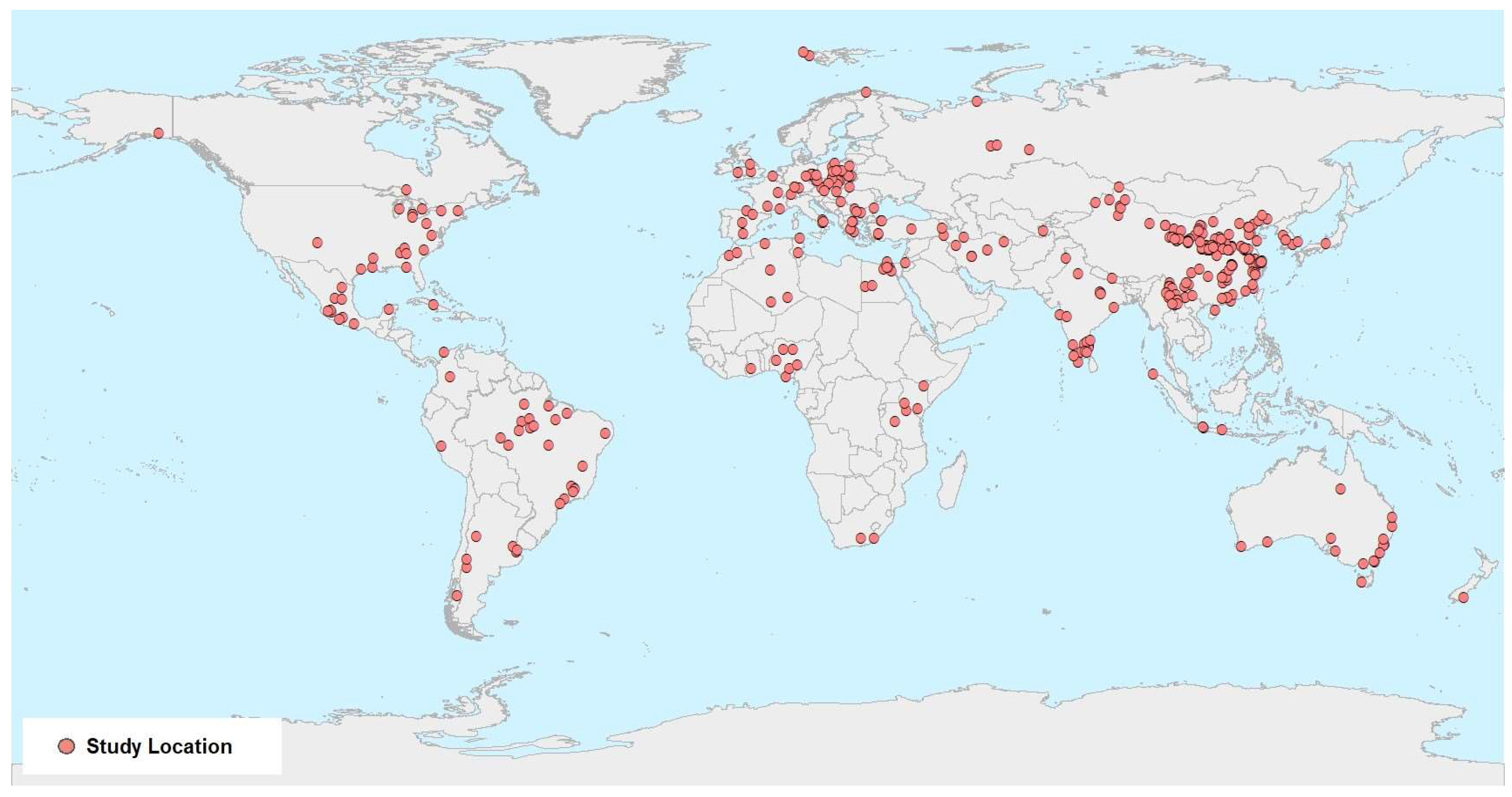
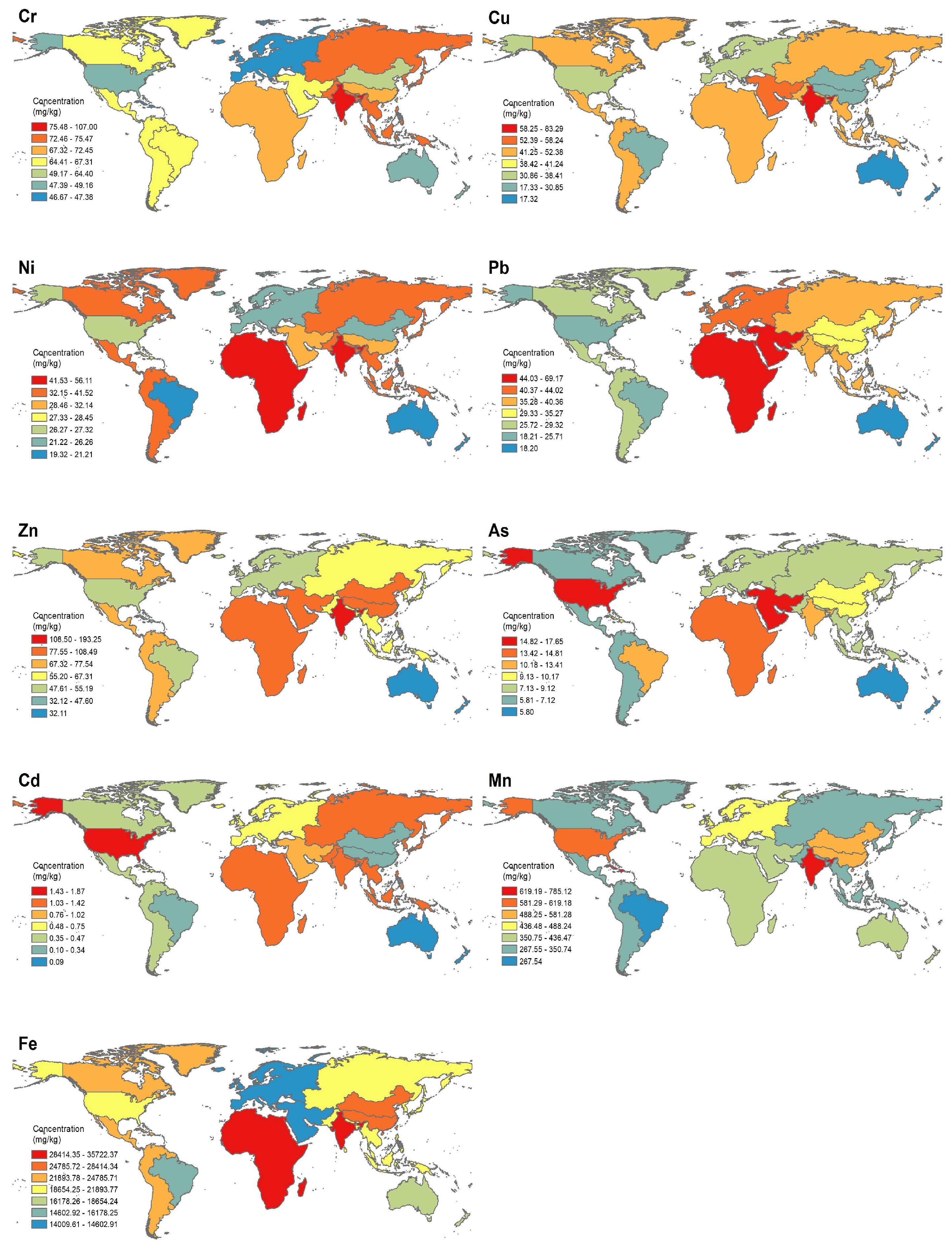

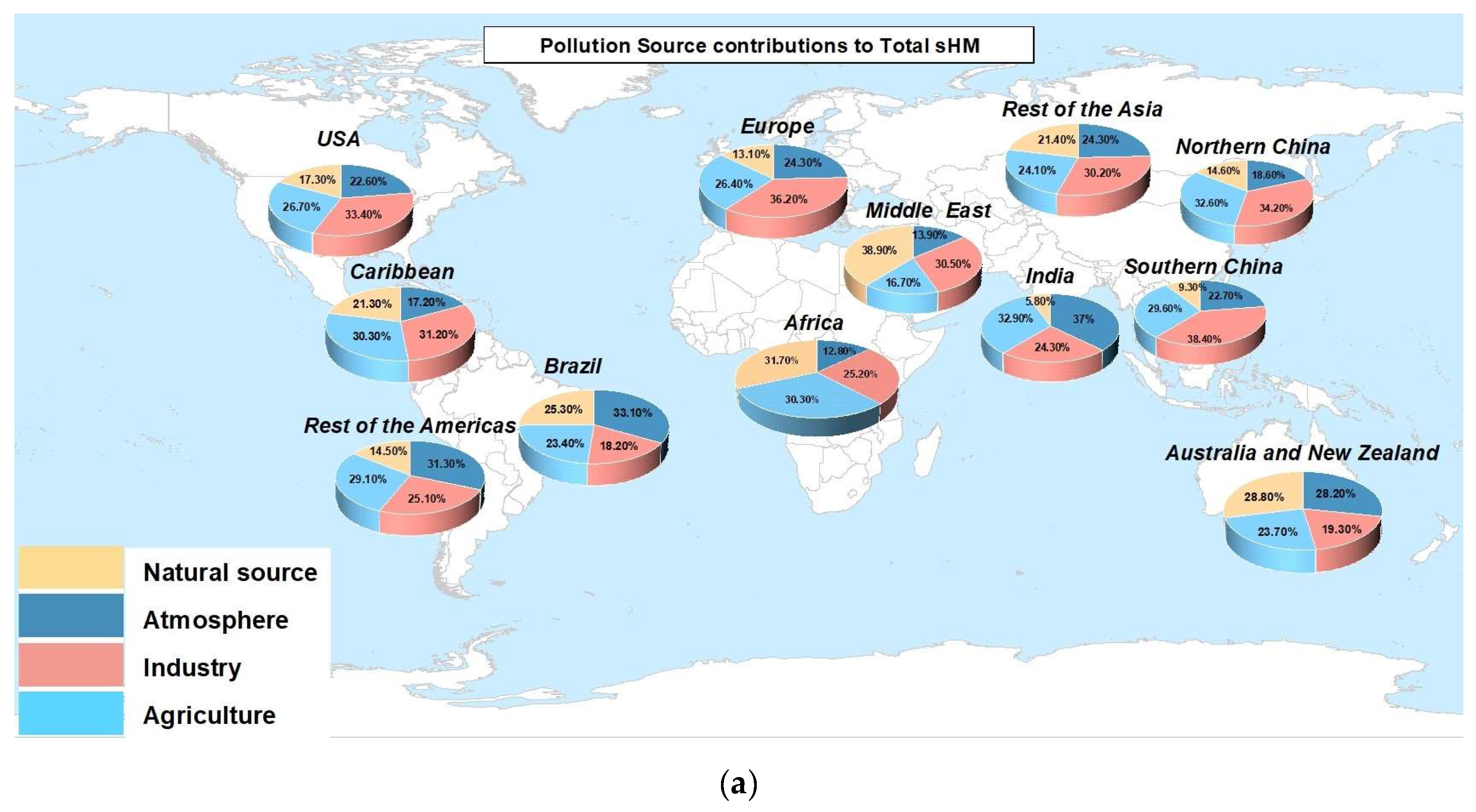
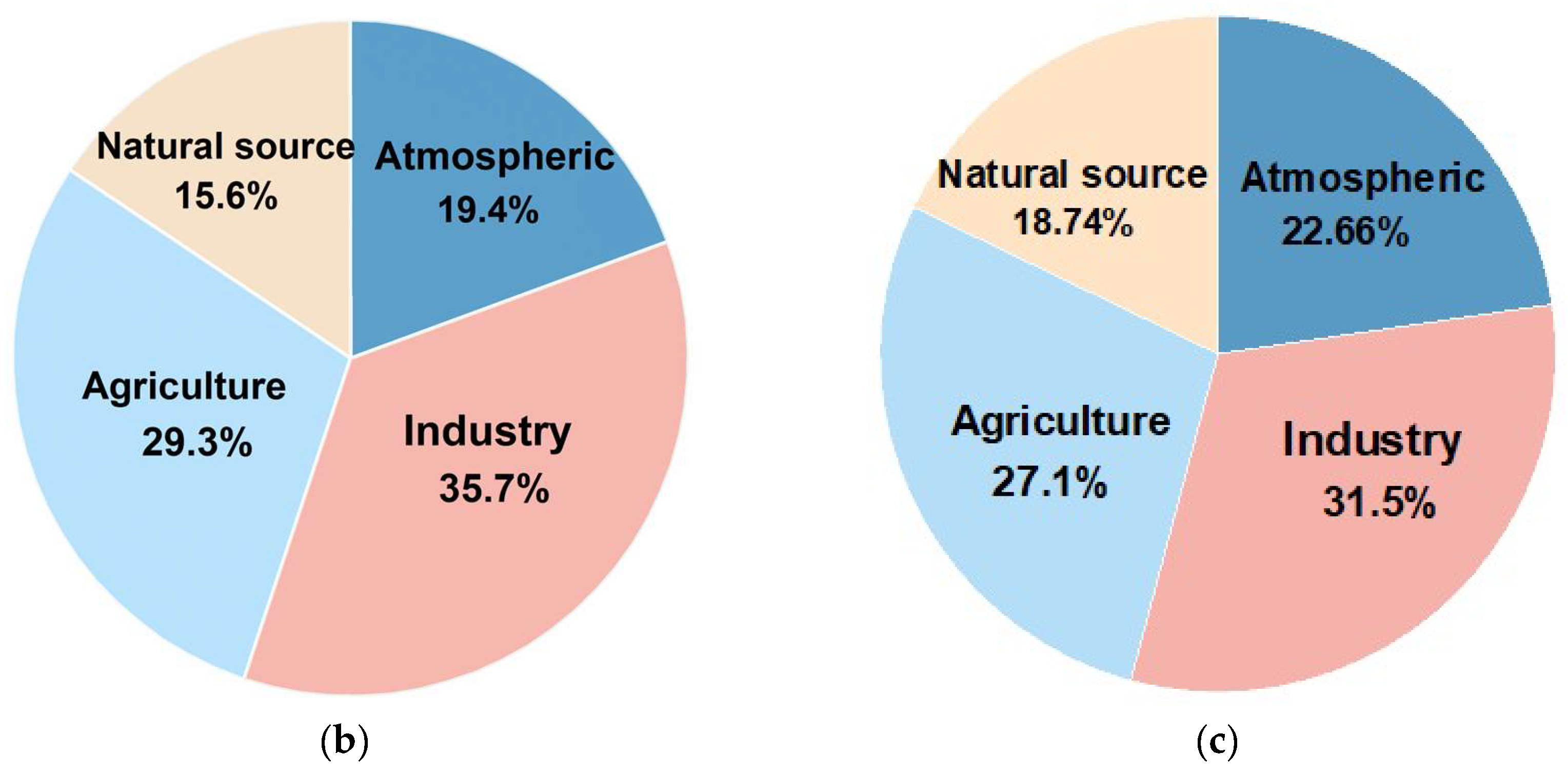

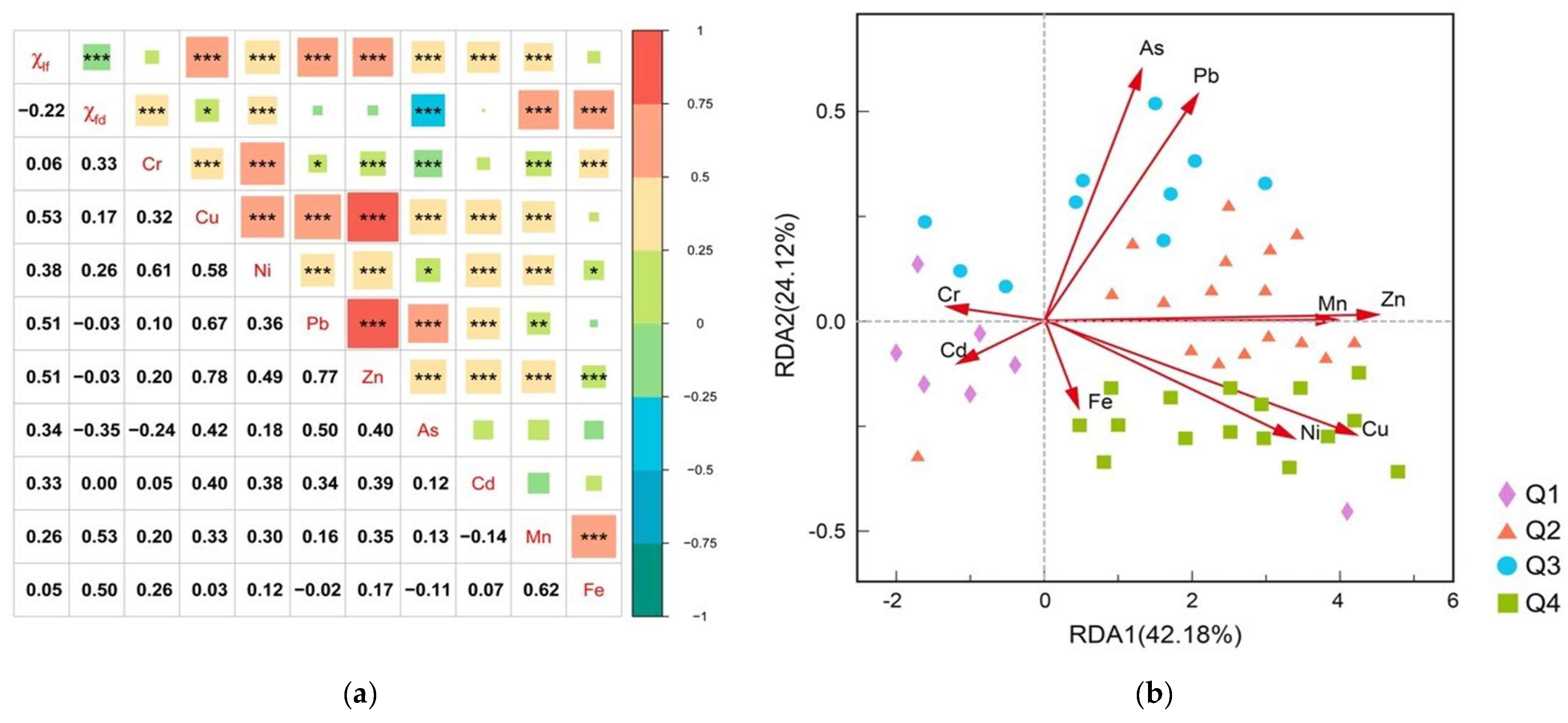
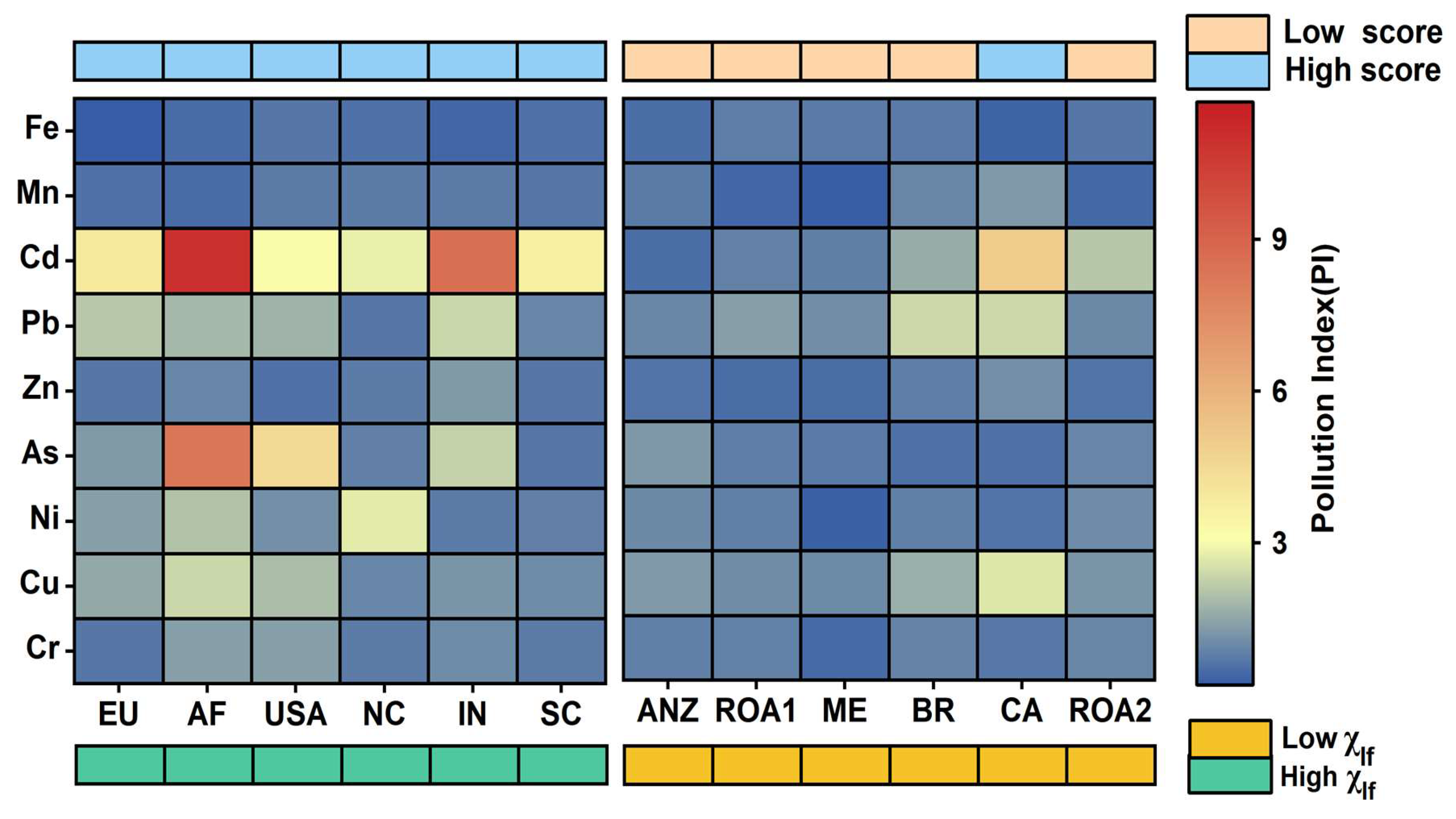
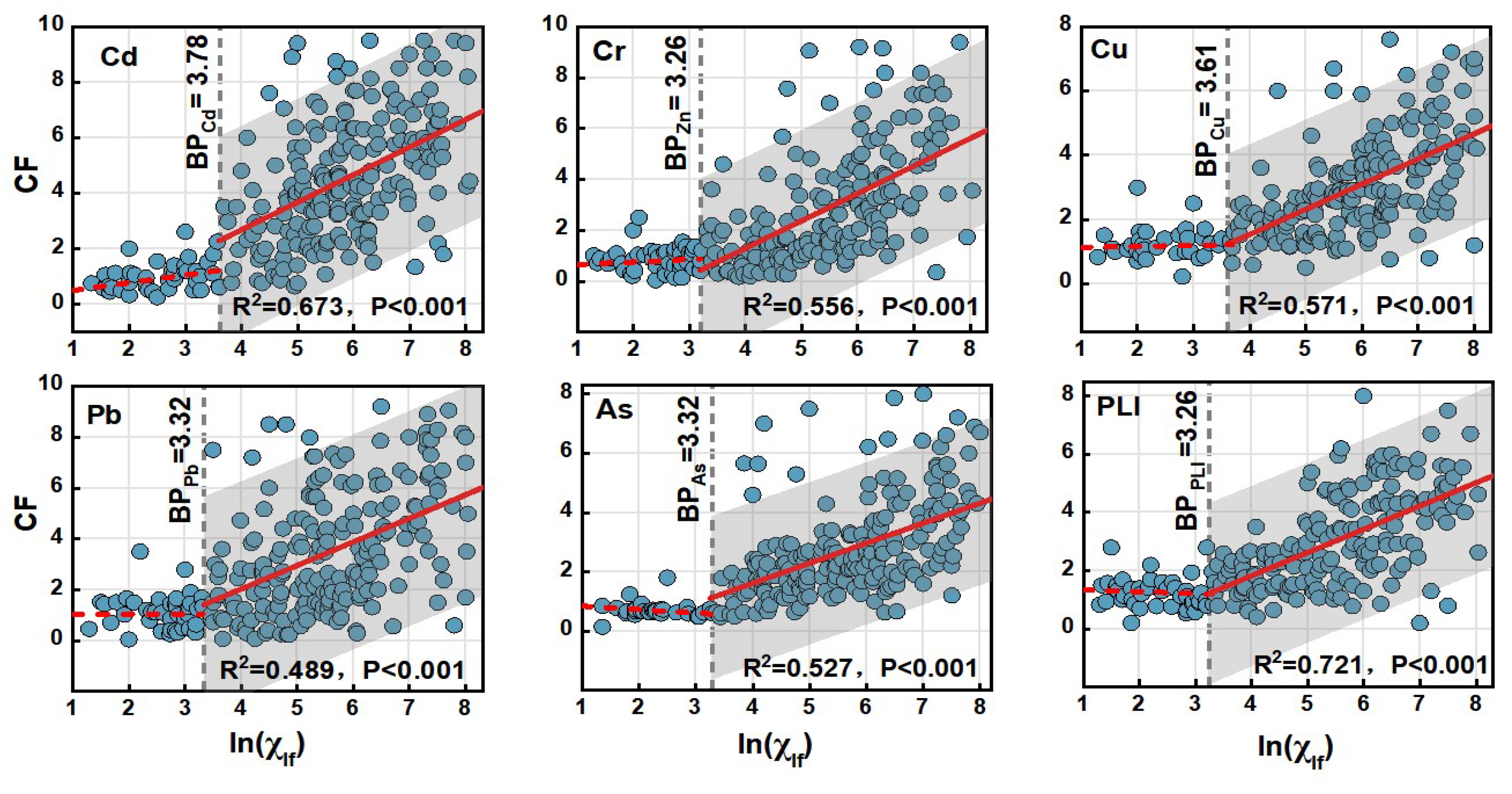
| Region | Abbreviation for Region or Country | Number of Records |
|---|---|---|
| Australia and New Zealand | ANZ | 18 |
| Europe | EU | 71 |
| Africa | AF | 26 |
| Northern America—USA | USA | 36 |
| Rest of America | ROA1 | 21 |
| Central America—Caribbean | CA | 14 |
| Middle East | ME | 15 |
| Southern America—Brazil | BR | 25 |
| Southern Asia—India | IN | 37 |
| Northern China | NC | 79 |
| Southern China | SC | 70 |
| Rest of Asia | ROA2 | 17 |
| World | - | 429 |
| Q1 | Q2 | Q3 | Q4 | |
|---|---|---|---|---|
| Range (×10−8 m3/kg) | 6.45~112.39 | 112.39~159.18 | 159.18~214.21 | 214.21~319.23 |
| Cr | Cu | Ni | Pb | Zn | As | Cd | Mn | Fe | ||
|---|---|---|---|---|---|---|---|---|---|---|
| 2001 [66] | 42 | 13-24 | 18 | 25 | 62 | 4.7 | 0.35 | 437 | - | |
| 2011 [67] | 59.5 | 38.9 | 29 | 27 | 70 | 6.83 | 0.41 | 488 | 22,979 | |
| This study | Mean | 64.84 | 43.57 | 35.54 | 32.52 | 74.23 | 10.69 | 0.58 | 523.24 | 22,495.7 |
| Min | 3.73 | 2.77 | 1.52 | 1.98 | 2.17 | 0.36 | 0.01 | 40.59 | 102 | |
| Max | 795.63 | 565 | 337.65 | 362.20 | 625.23 | 71.27 | 9.6 | 2459.91 | 75,235 | |
| SD | 86.32 | 136.46 | 47.64 | 64.44 | 100.96 | 10.34 | 0.97 | 221.48 | 16,245.52 | |
| HM | Thresholds | Regression Equation | Correlation Coefficient | |
|---|---|---|---|---|
| Cd | 3.78 | 43 | ) − 0.23 | 0.673 |
| Cr | 3.26 | 26 | ) − 2.52 | 0.556 |
| Cu | 3.61 | 37 | ) − 1.31 | 0.571 |
| Pb | 3.32 | 28 | ) − 0.98 | 0.467 |
| As | 3.32 | 28 | ) + 1.21 | 0.483 |
| PLI | 3.26 | - | ) − 0.83 | 0.721 |
Disclaimer/Publisher’s Note: The statements, opinions and data contained in all publications are solely those of the individual author(s) and contributor(s) and not of MDPI and/or the editor(s). MDPI and/or the editor(s) disclaim responsibility for any injury to people or property resulting from any ideas, methods, instructions or products referred to in the content. |
© 2024 by the authors. Licensee MDPI, Basel, Switzerland. This article is an open access article distributed under the terms and conditions of the Creative Commons Attribution (CC BY) license (https://creativecommons.org/licenses/by/4.0/).
Share and Cite
Zhao, X.; Zhang, J.; Ma, R.; Luo, H.; Wan, T.; Yu, D.; Hong, Y. Worldwide Examination of Magnetic Responses to Heavy Metal Pollution in Agricultural Soils. Agriculture 2024, 14, 702. https://doi.org/10.3390/agriculture14050702
Zhao X, Zhang J, Ma R, Luo H, Wan T, Yu D, Hong Y. Worldwide Examination of Magnetic Responses to Heavy Metal Pollution in Agricultural Soils. Agriculture. 2024; 14(5):702. https://doi.org/10.3390/agriculture14050702
Chicago/Turabian StyleZhao, Xuanxuan, Jiaxing Zhang, Ruijun Ma, Hui Luo, Tao Wan, Dongyang Yu, and Yuanqian Hong. 2024. "Worldwide Examination of Magnetic Responses to Heavy Metal Pollution in Agricultural Soils" Agriculture 14, no. 5: 702. https://doi.org/10.3390/agriculture14050702
APA StyleZhao, X., Zhang, J., Ma, R., Luo, H., Wan, T., Yu, D., & Hong, Y. (2024). Worldwide Examination of Magnetic Responses to Heavy Metal Pollution in Agricultural Soils. Agriculture, 14(5), 702. https://doi.org/10.3390/agriculture14050702





